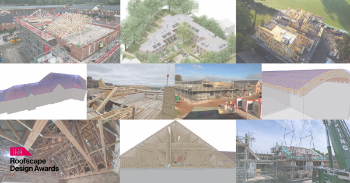Knapping

|
| Knapped stonework was often used for important buildings constructed during Norman and Saxon periods. One example is the Norwich Guildhall, built in the 1400s. The east end (pictured above) illustrates an example of smooth, chequerboard (or diaper) flushwork of knapped flint and light limestone. The stones are square-knapped to such a degree that galetting was not required - neither was mortar. |
Knapping is a technique used to shape flint (or other stone with similar characteristics). The purpose of knapping is to split the stone and make it into flat squares or other distinct shapes for decorative purposes.
The residual flakes of stone that are created as a result of knapping are sometimes saved and used to fill spaces and protect any exposed mortar. This technique is known as galetting.
In the case of knapped flint, the technique highlights the smooth black surface of flint, which can be framed in limestone. This treatment is called flushwork - the decorative use of knapped flint in conjunction with dressed stone to form patterns.
See also: Building with Flint: a practical guide to the use of flint in design and architecture.
[edit] Related articles on Designing Buildings
Featured articles and news
Moisture, fire safety and emerging trends in living walls
How wet is your wall?
Current policy explained and newly published consultation by the UK and Welsh Governments.
British architecture 1919–39. Book review.
Conservation of listed prefabs in Moseley.
Energy industry calls for urgent reform.
Heritage staff wellbeing at work survey.
A five minute introduction.
50th Golden anniversary ECA Edmundson apprentice award
Showcasing the very best electrotechnical and engineering services for half a century.
Welsh government consults on HRBs and reg changes
Seeking feedback on a new regulatory regime and a broad range of issues.
CIOB Client Guide (2nd edition) March 2025
Free download covering statutory dutyholder roles under the Building Safety Act and much more.
AI and automation in 3D modelling and spatial design
Can almost half of design development tasks be automated?
Minister quizzed, as responsibility transfers to MHCLG and BSR publishes new building control guidance.
UK environmental regulations reform 2025
Amid wider new approaches to ensure regulators and regulation support growth.
The maintenance challenge of tenements.
BSRIA Statutory Compliance Inspection Checklist
BG80/2025 now significantly updated to include requirements related to important changes in legislation.
Shortlist for the 2025 Roofscape Design Awards
Talent and innovation showcase announcement from the trussed rafter industry.






















